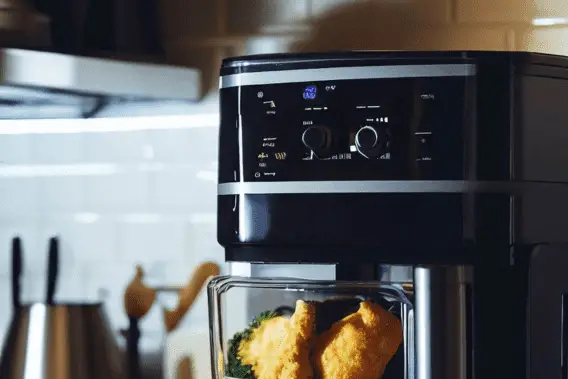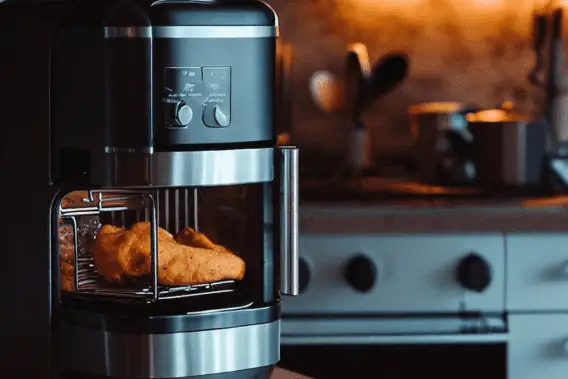How long should I preheat my air fryer before cooking? That’s a common question many air fryer users have, especially when they’re eager to experience the crispy texture of foods cooked using this popular kitchen appliance.
To get the best results, you should generally preheat your air fryer for about 2-5 minutes, depending on the model and wattage.
Why Preheat an Air Fryer?
Preheating an air fryer isn’t just a step mentioned in the recipe guidelines; it’s an integral part of the air frying process. Preheating warms up the cooking basket and ensures that the heating element reaches the desired temperature setting.
When you place your food in a preheated air fryer, it starts cooking immediately. This quick cooking method ensures even cooking, moisture retention, and that desired crispy texture we all crave.
Factors Affecting Preheat Time
Several factors influence how long you should preheat your air fryer:
Fryer Model and Wattage: Different air fryer models have different wattage. A higher wattage air fryer will heat up faster than a lower wattage one.
Size and Cooking Capacity: Larger air fryers with a bigger cooking basket might take a bit longer to preheat compared to smaller ones.
Temperature Setting: If you’re setting your air fryer to a higher temperature, it might require a few more minutes to reach that temperature. The digital display on most modern air fryers provides an accurate indication of the current temperature.
Benefits of Preheating
The process of preheating serves several essential purposes:
Even Cooking: Preheating ensures that foods are cooked uniformly. This is particularly crucial for foods that need a crispy texture on the outside while remaining juicy inside.
Efficiency and Time-Saving: Air frying is known for its efficiency. By preheating, you’re ensuring that the food cooks faster, saving you precious minutes, especially when preparing meals on a tight schedule.
Optimal Results: For those who follow cookbook recommendations closely, preheating ensures that you get results as described in the recipe. Be it the perfect browning, crispiness, or flavor, preheating makes a difference.

Understanding Air Circulation in Air Fryers
Air fryers work on the principle of rapid air technology. This technology circulates hot air around the food in the cooking basket, ensuring quick and even cooking. The convection mechanism is key to achieving that crispy texture without the need for excessive oil.
Rapid Air Technology: This technology is what differentiates air fryers from traditional frying methods. It allows for oil-less cooking, which not only offers health benefits but also ensures that the food retains its flavor and moisture.
Food Placement Matters: To maximize the benefits of air circulation, it’s essential to place food in the basket in a single layer. Overcrowding can lead to uneven cooking.
Ventilation: The hot air needs an outlet. Ensure that your air fryer is placed in a location with adequate ventilation. This prevents smoke and allows for better cooking.
The Importance of Temperature Control
Every food type has an optimal temperature range for air frying. Ensuring you’ve set the right temperature is crucial for the end result.
Manual Temperature Control vs. Cooking Preset: Some air fryers come with preset cooking options for popular foods like fries or chicken. These presets automatically adjust the temperature and cook time. However, for unique recipes or specific food types, manual temperature control gives you more flexibility.
Ready Indicator: Modern air fryers often come with a ready indicator, usually a light or a beep, signaling when the fryer has reached the desired temperature. This feature aids in ensuring optimal cooking conditions.
Cook Time Adjustment: Depending on the food’s thickness and type, you might need to adjust the cook time. For instance, frozen foods might require a bit more time than fresh ones.

Maintenance and Safety Features
Owning an air fryer is not just about cooking; it’s also about ensuring it lasts long and is safe to use.
Cleaning and Maintenance: Regular cleaning is crucial. Most air fryers come with a non-stick basket, which makes clean-up easier. However, it’s essential to ensure no food residues remain, as they can affect the fryer’s efficiency.
Basket Removal and Safety: Ensure the basket is securely placed before starting the fryer. Most fryers come with safety features that prevent them from operating if the basket isn’t properly secured.
Energy Consumption and Efficiency: Air fryers are energy efficient, but it’s good practice to unplug them when not in use. Also, placing the fryer on a stable, heat-resistant surface ensures safety and optimal results.
Final Thoughts
Air fryers have revolutionized our kitchens, offering a healthier, quicker, and more efficient way to cook our favorite meals. By understanding the importance of preheating, mastering the nuances of temperature control, and ensuring proper maintenance, you can make the most of this innovative appliance.
With every crispy bite, you’re not only savoring deliciousness but also the convenience and health benefits that come with air frying. So, the next time you’re about to whip up a dish in your air fryer, remember these tips and enjoy optimal results.
Keep experimenting, keep cooking, and most importantly, keep enjoying the mouth-watering outcomes!
FAQs
No, one of the main advantages of air fryers is oil-less cooking. However, a light spray can enhance crispiness.
Yes, but ensure they have similar cooking times and temperatures. Also, avoid overcrowding for even cooking.
Most modern air fryers have a ready indicator, like a light or a beep, to signal when they’ve reached the desired temperature.
Air fryers come in a range of prices, with various features. While some high-end models can be pricey, there are plenty of budget-friendly options available.
Most air fryers have a non-stick basket, making them relatively easy to clean. Regular cleaning ensures the fryer’s longevity and efficiency.
Yes, higher wattage air fryers typically heat up and cook faster than those with lower wattage.

